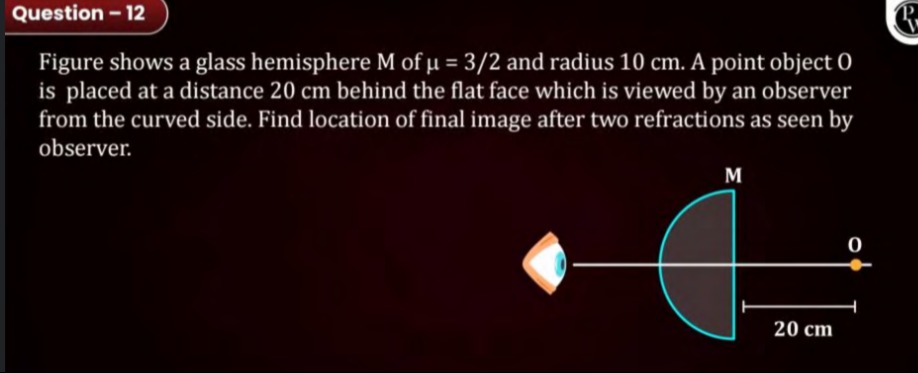Question
Question: Figure shows a glass hemisphere M of $\mu = 3/2$ and radius 10 cm. A point object O is placed at a d...
Figure shows a glass hemisphere M of μ=3/2 and radius 10 cm. A point object O is placed at a distance 20 cm behind the flat face which is viewed by an observer from the curved side. Find location of final image after two refractions as seen by observer.

10 cm behind the flat face
10 cm in front of the flat face
30 cm behind the flat face
30 cm in front of the flat face
The final image is formed at a distance of 10 cm behind the flat face.
Solution
The problem involves two refractions: first at the flat face and then at the curved face.
Step 1: Refraction at the flat face. The object O is in air (n1=1) at a distance u1=20 cm from the flat face. The light enters the glass hemisphere (n2=3/2). For a plane surface, the radius of curvature is infinite (R1=∞). The refraction formula is vn2−un1=Rn2−n1. For a plane surface, this simplifies to v1n2=u1n1. Using the sign convention where distances to the right of the surface are positive: u1=+20 cm. v13/2=+201 v1=23×20=+30 cm. The first image I1 is formed at a distance of 30 cm to the right of the flat face.
Step 2: Refraction at the curved face. The first image I1 acts as the object for the curved surface. This is the interface between glass (n1=3/2) and air (n2=1). The observer is viewing from the curved side (air). The object distance u2 is the distance of I1 from the pole of the curved surface. Assuming the flat face is at x=0, the curved surface is part of a sphere with its center of curvature at x=−R=−10 cm. The pole of the curved surface is at x=0. The object I1 is at x=+30 cm. Therefore, u2=+30 cm. The radius of curvature of the curved surface is R2=−10 cm (negative because the center of curvature is on the left of the pole, which is the side of the incident ray). Applying the refraction formula: v2n2−u2n1=R2n2−n1 v21−+303/2=−101−3/2 v21−201=−10−1/2 v21−201=201 v21=201+201=202=101 v2=+10 cm.
The final image is formed at a distance of 10 cm to the right (behind) of the flat face.
